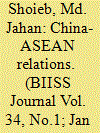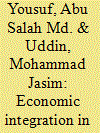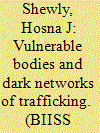|
|
|
Sort Order |
|
|
|
Items / Page
|
|
|
|
|
|
|
| Srl | Item |
| 1 |
ID:
120935


|
|
|
|
|
| Publication |
2013.
|
| Summary/Abstract |
Asia-Pacific region is an important part of the globe as competing interests of big powers often generate conflict to the ground. Over the past decade, the world has witnessed rapid development between Association of South East Asian Nations (ASEAN) and China. Historically China tries to maintain a very good relation with its neighbouring countries. When China was the middle kingdom in 1300A.D.-1900 A.D., it maintained a very close tie with its neighbours. China is rising again as a formidable global power; and its rise is one of the most critical developments in the contemporary world. In the eve of rising, China gives value to the relationship with the ASEAN. Since the beginning of ASEAN in 1967, China maintained relations with the regional association. However, it was the late 1980s that China started to intensify its efforts to establish diplomatic relations with ASEAN member states. In recent years, both are closer to each other than before. Even though, differences exist between the two; for example, the case of South China Sea. Their relations are more focused on economic cooperation; however, strategic partnerships continue. This paper studies phase-wise trends, and critical issues of ChinaASEAN relations.
|
|
|
|
|
|
|
|
|
|
|
|
|
|
|
|
| 2 |
ID:
120934


|
|
|
|
|
| Publication |
2013.
|
| Summary/Abstract |
In theory, integrating economies of various countries means unifying their policies on trade and economy as well as reducing several barriers on the two. The motivations of such economic integration are rationalising comparative advantages and increasing economic productivity. In South Asia, economic integration continues with several setbacks, even though South Asian Association for Regional Cooperation (SAARC) is aimed at promoting regionalisation with a firm belief that an effective economic integration process can forward the region towards economic prosperity and development. This paper conceptualises the meaning of economic integration, discusses the factors of economic integration in South Asia and makes an endeavour to address the difficulties of economic integration in the region. The paper concludes with the argument that the outcomes attained in regards to the integration are insignificant, although there are some arrangements that could assist the progress of South Asian economic integration.
|
|
|
|
|
|
|
|
|
|
|
|
|
|
|
|
| 3 |
ID:
120936


|
|
|
|
|
| Publication |
2013.
|
| Summary/Abstract |
By now, ensuring Good Urban Governance (GUG) has been one of the major challenges for urban government in the developing countries. Though the main objective of GUG is to ensure equal facilities to urban people, in most cases, it is not materialised. One of the reasons is lack of proper urban planning and management, which by and large, results in unplanned growth of slums and illegal settlement. Due to rapid migration of people from rural to urban areas, urban governments are facing numerous challenges to meet the basic needs of urban people. The rapid inflow of additional people creates extra pressure on water, housing, electricity, gas and other means of survival. This has also instigated various social, political, institutional, economic and structural forms of violence in the cities. At present, urban governments of many developing countries have failed to tackle various forms of crimes and delinquencies. This raises the important query as to how GUG is interlinked with urban security issues? It is in this context that the major objectives of the paper are to perceive the overall phenomenon and outline the various dimensions of urban insecurity issues in relations with the GUG. Based on the evidences of violent activities in different cities, some key challenges of urban government have been discussed. Deriving the causes and consequences of urban violence, some recommendations have been put forward from developing country context.
|
|
|
|
|
|
|
|
|
|
|
|
|
|
|
|
| 4 |
ID:
120938


|
|
|
|
|
| Publication |
2013.
|
| Summary/Abstract |
This paper attempts to examine the impact of the 'Challenging the Frontiers of Poverty Reduction-Targeting the Ultra Poor' (CFPR-TUP) programme on landholdings and food security of the ultra poor using a large balanced panel dataset (2002, 2005 and 2008). The main objective of this paper is to explore short- and long-term impact of the programme on landholdings and food security of the ultra poor using conditional and unconditional difference-indifferences (DID) methods. In addition, fixed effects estimation is also applied to check the robustness of the estimates on this certain outcomes of landholdings like total landholdings, access to land, land-man ratio and chronic food deficit after capturing the unobserved heterogeneity. In particular, this paper examines the distinction between treatment and control groups in the base year. This study (based on proportion as a unit of measurement) finds the robustness of impact estimates in the long-term for homestead, cultivable and total landholdings using both DID approaches, which also find short- and long-term robust impact for cultivation of others' land, access to land and leasing. After using decimal as a unit of measurement, this study finds the long-term robust impact on homestead, total land owned, access to land and land-man ratio. Here this study does not find robust impact on cultivable land and cultivation of others' land both in short- and long-term. Fixed effects method is applied on total land owned, access to land and land-man ratio. The findings suggest that the CFPR has robust impact on total land owned, access to land and land-man ratio only in the long-term irrespective of the approaches. To check the channel between landholdings and food security, fixed effects method is applied only for chronic food shortage and DID methods are applied to all self-perceived food safety issues like chronic and occasional food deficit, break-even and food surpluses. All three approaches provide very much consistent results for short- and long term impact. All three approaches validate robustness of impact on chronic food deficit suggesting households belong to the programme face Significantly less chronic food shortages compared to the control.
|
|
|
|
|
|
|
|
|
|
|
|
|
|
|
|
| 5 |
ID:
120933


|
|
|
|
|
| Publication |
2013.
|
| Summary/Abstract |
Globally, trafficking is now a thriving and multi-billion dollar business run by organised criminal networks. An estimated 8, 00,000 women and children are trafficked each year across international borders, 80 percent ending in forced sex work. Although awareness is increasing, human trafficking still lack a global understanding of the subject, what United Nations Office on Drug and Crime identifies as 'a knowledge crisis about a crime that shames us all'. Bangladesh is predominantly an origin country for victims of trafficking while India is an origin, transit and destination country for this organised crime. In this context, Bangladesh-India border, the fifth longest land border of the world, is intensively used for women and girls trafficking in South Asia. The traffickers capitalise on complex political landscape of the border and borderland, poor border control mechanisms and lack of joint efforts to stop human trafficking. This paper contributes to the efforts to prevent human trafficking along this border. The main thrust of this article is to address the routes and networks of trafficking at the Bangladesh-India border, which is poorly addressed in academic writing. Here, this paper highlights on the aspects of human trafficking along this border and prioritises on joint initiatives by the border guards to reduce the magnitude of human trafficking significantly.
|
|
|
|
|
|
|
|
|
|
|
|
|
|
|
|
|
|
|
|
|